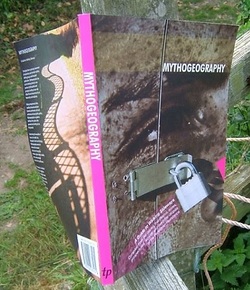Buy the Paperback (£15):
Save 20% when you buy any book direct from us. Use promotion code tpdirect at checkout for an automatic 20% discount.
Imprint: Triarchy Press
Published: 2010 Format: Paperback Extent: 256pp. Size: 17 x 24.4 cm List Price: £15.00 Use code to save 20% ISBN: 978-0-9562631-3-1 Tags: drift, derive, wrights & sites, mythogeography, mis-guide, psychogeography, improvisation, phil smith Mythogeography CrabMan (Phil Smith) Buy the eBookThe ebook is text only - it does not contain any of the hundreds of images in the print version.
Buy the ePub version for
PC/Mac/Tablet/iPad ebook ISBN: 9781909470408 Kindle versions: amazon.co.uk | amazon.com Readership
Mythogeography is a book for walkers, artists who use walking in their art, students who are discovering and studying a world of resistant and aesthetic walking, anyone troubled by official guides to anywhere, urbanists, geographers, site-specific performers, town planners and un-planners, urban explorers, entrepreneurs and activists who don’t want to drive to the revolution.
For a detailed, extended and very helpful review of the book and its main ideas by Ken Wilson, please see Reading and Walking No.24.
|
Since 1998 ‘mythogeography’ has developed as a paranoid, exploratory, detective-like approach to space and place. It has prioritised anomalies and ‘in-betweeness’, working in gaps, extolling ‘voids’, and constructing general ideas from the ‘and and and’ of the accumulation and assemblage of disparate parts (Deleuze and Guattari).
But it has also given attention to patterns, chiming with Roger Penrose’s assertion that ‘the mathematics are out there’, assuming such patterns to be an emergent meaning in themselves. Part of that attention to patterns has been a careful positioning in respect of ‘myth’, attempting to use ‘limited myth’; mythic-like accounts which are capable of symbolically representing patterns (e.g. of power or cultural paradigms) but are rendered questionable by their popular-cultural exploitation, blatant fiction or absurdity. Read more Mythogeography
|
Read more:
About the author
Snippets Not psychogeography Drift, drive, thrift, thrive Reviews 5 Ways to Use a Map See our other books on Walking As the author puts it:
From the transnational pilgrim to the person who 'drifts off' on the way to the shops, Mythogeography addresses the means, uses and consequences of 'walking sideways', of deploying the ordinary act of walking as a lever to prise the lid off everyday life. This book is not entirely conventional. It consists of an assemblage of sometimes unreliable, sometimes fractious documents hung around a flawed, yet epic tale of a journey in search of oak trees. It floats numerous narratives around this travelogue, weaving a matrix of possible trajectories for the reader from passive contemplation to wild pilgrimage and activist pedestrianism. The book's second half contains advice, tasks, guidance, kits and mental maps: a toolbag of information and suggestions for the reader who wants to take the next step. Mixing entrepreneurial drive, rambling discourses and post-dramatic performance with soft architecture and post-politics-politics, Mythogeography is a guide to strolling in the cracks in the pavement and a means to walking out on the Spectacle. |
Watch the author suggest How to Walk a City...

